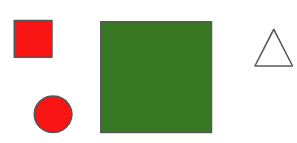The Importance of Fractions
“No area of elementary school mathematics is as mathematically rich, cognitively complicated, and difficult to teach as fractions, ratios, and proportionality. These ideas all express mathematical relationships: fractions and ratios are ‘relational’ numbers. They are the first place in which students encounter numerals like ‘¾’ that represent relationships between two discrete or continuous quantities rather than a single discrete (‘three apples’) or continuous quantity (‘4 inches of rope’). (Litwiller & Bright, 2002)
Students begin to explore the idea of fractions at a very early age. Have you ever split a sandwich or a cookie in half so it can be split between two siblings? One of them will invariably cry “My half is smaller!” They have a natural sense of equal parts and fair sharing. Although children this young would not be expected to represent the idea of one half abstractly, concrete representations of one half are within their grasp. “It is important to focus on one half as a key mathematical idea and to recognise that sharing in even quantities is usually found to be easier.” (Espresso Research, 2019) Too often we rush and move students’ experiences with fractions beyond one half far too quickly. One half is a benchmark that will be used constantly as students move forward in their conceptual understanding of fractions by exploring other fractions.
“Fractions are complex and composed of multiple meanings.” (Kierent, 1976) Fractions can be represented using the length model (a number line: 1 represents the whole), an area model (one shape represents the whole), a volume model (3 dimensional figure represents the whole, ie. measuring cups) and a set model (collection of items represents the whole amount). Fractions can be parts of wholes (ie. half of a square), parts of sets (ie. 3 out of 10 toys), the result of dividing two numbers (3 / 5), operators (enlarging by one half) or measures (ie. rulers).
“The complicated semantics of fractions is, in part, a consequence of the composite nature of fractions. How is the meaning of 2 combined with the meaning of 3 to generate a meaning or ⅔?” (Ball, 1993). There is a relationship between the numerator and denominator but a fraction is a single quantity.
Misconceptions
There are several prevalent misconceptions students hold around additive thinking. As you read the misconception statements below, can you determine when and why these misconceptions
- are developed?
- are interfering with developing new understandings?
Misconception 1:
All ½’s (for example) are equal. “Student does not understand that the size of the whole determines the size of the fractional part.” Source
Misconception 2:
“Student does not understand that when finding fractions of amounts, lengths, or areas, the parts need to be equal in size.” (though not necessarily equal in shape) Source
Misconception 3:
“Student thinks that when finding fractions using area models, the equal-sized pieces must look the same.” Source
Misconception 4:
Student thinks that parts always have to be equal in size, even when dealing with a fraction set. Source

Misconception 5:
“Dividing by one-half is the same as dividing in half.” Source
Misconception 6:
“Doubling the size of the denominator doubles the size of the fraction.” Source
Misconception 7:
“Dividing the numerator and denominator by the same number reduces the value of the fraction” Source
Students need to understand
“Fraction size is relative. A fraction by itself does not describe the whole or the size of the parts. A fraction tells us only about the relationship between the part and the whole.” Source
High Leverage Strategies
Coming Soon.
Further Learning
Explore the presentation “Student Misconceptions Aligned with the Fractions Learning Pathway: Uncovering Misconceptions Through Student Clinical Interviews” to dig deeper into answering the following questions:
- As you consider the Fractions Learning Pathway provided, how might this align to Alberta Curriculum?
- The first task presented (pg. 7) asks students to identify which represents a half. What misconceptions might create challenges in selecting the correct answers?
- As you explore the misconception trends, what representations have you used in your classroom to help address these misconceptions?
Be aware that this presentation was created for Ontario teachers using Ontario curriculum. Be mindful of the correlation of the grade levels to Alberta curriculum.
References
Ball, D. (1993). Halves, pieces and twoths: Constructing and using representational contexts in teaching fractions. In T.P. Carpenter, E. Fennema & T. A. Romber (Eds). Rational Numbers: An Integration of Research (pp. 157-195). Routledge.
Fannin, J., Bailey, M., Brown, N., & C. H. (n.d.). Student Misconceptions Aligned with the Fractions Learning Pathway [PDF].
Fractions A set of intertwined constructs. (2019, November). Espresso Research, Issue 25, 1.
Kierent, T. (1976). On the mathematical, cognitive, and instructional foundations of rational numbers. In Number and Measurement: Papers from a Research Workshop (pp. 101-144). Columbus: ERIC/SMEAC.
Litwiller, B. H., & Bright. G. W. (2002). Making sense of fractions, ratios, and proportions: 2002 yearbook. Reston, VA: National Council of Teachers of mathematics.
Misconceptions and Errors [PDF]. (n.d.) America’s Choice Mathematics Navigator.




